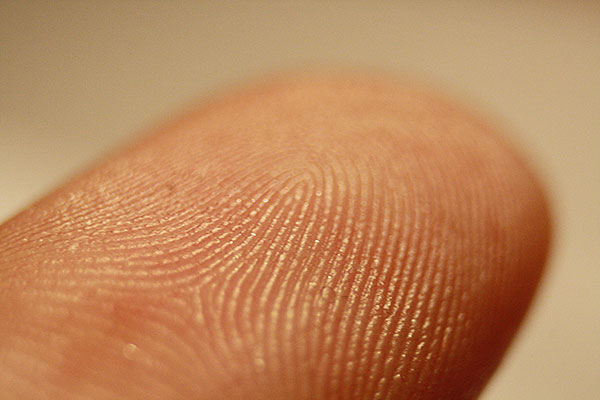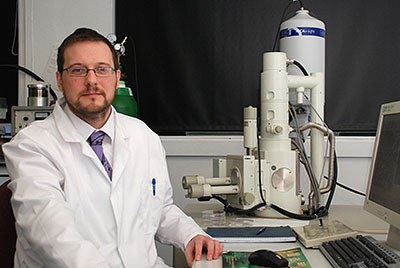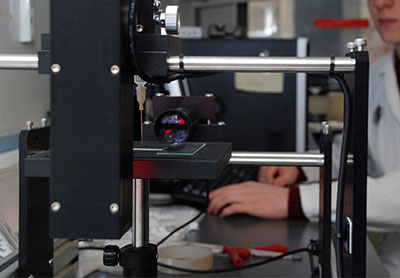Fingerprint forensics find unmasks fraudsters and counterfeiters

Wed, 10 Dec 2014 15:22:00 GMT
Forensics breakthrough provides detailed chemical map of the layers on laser-printed paper – including fingerprints
 FOR more than a century, fingerprints have been crucial to the investigation of crime and are still responsible for more identifications than DNA evidence. Now, a University of Huddersfield researcher is responsible for breakthroughs that will make fingerprinting a more valuable forensic tool than ever. Fraudsters are among the offenders who will be easier to detect, thanks to the work of Dr Benjamin Jones.
FOR more than a century, fingerprints have been crucial to the investigation of crime and are still responsible for more identifications than DNA evidence. Now, a University of Huddersfield researcher is responsible for breakthroughs that will make fingerprinting a more valuable forensic tool than ever. Fraudsters are among the offenders who will be easier to detect, thanks to the work of Dr Benjamin Jones.
He headed a team that has discovered a technique for taking fingerprints from laser-printed paper and – crucially – detecting whether or not the mark was made before or after it was printed on.
An award-winning article describing the new technique explains that “in cases such as fraud or counterfeiting it can be imperative to know whether a fingerprint has been deposited before or after the paper is printed with compromising material, and therefore be able to assess whether a suspect is associated with the printed evidence”.
In a project that received £170,000 funding from The Leverhulme Trust, Dr Jones and his team discovered that a scientific technique known as secondary ion mass spectrometry (SIMS) – which analyses surfaces at the microscale – can provide a detailed chemical map of the layers on laser-printed paper – including fingerprints – and the order in which they were deposited. This means, for example, that a suspect could no longer claim that he or she had handled a piece of blank paper when simply refilling a photocopier or printer.
Award-winning paper
The article describing the successful research project was published in Science and Justice, which is the journal of the Chartered Society of Forensic Sciences. It was then selected for the P.W. Allen Award, which is bestowed by the editor of the journal and the council of the Society on the paper adjudged to be the best of its year.
 The article was written as “proof of concept”, says Dr Jones – who is a Senior Lecturer in the University of Huddersfield’s School of Applied Sciences – and the SIMS technique for analysing fingerprints on laser-printed paper is ready to be pressed into service. The process of analysis would probably be outsourced to universities equipped with the necessary spectrometry technology.
The article was written as “proof of concept”, says Dr Jones – who is a Senior Lecturer in the University of Huddersfield’s School of Applied Sciences – and the SIMS technique for analysing fingerprints on laser-printed paper is ready to be pressed into service. The process of analysis would probably be outsourced to universities equipped with the necessary spectrometry technology.
Dr Jones is a physicist by background – with special expertise in surfaces – and he became involved in forensics when taking part in research at University College London that aimed to discover if it was possible to recover data from mobile phones that had been destroyed in explosions. This meant he was developing the use of surface-sensitive techniques that could then be applied to other areas of forensics, such as fingerprints, and it led to an ongoing research association with the Home Office. Dr Jones is now investigating the use of micro-scanning techniques that will enable criminal investigators to gain additional information from surfaces such as bank notes.
The Home Office is also contributing funding for Dr Jones and his PhD student at the University of Huddersfield, Bulgarian-born Krastio Popov, to investigate a technique named “vacuum metal deposition”, which can be used develop fingerprints by applying a very thin layer of metal to a surface.
“The issue is that sometimes the development of the finger marks can be very different, depending on the surface or the age of the print, and we are trying to work out why, which includes some of the different behaviours of the fingerprint at the nano-scale as it changes with time,” said Dr Jones.







